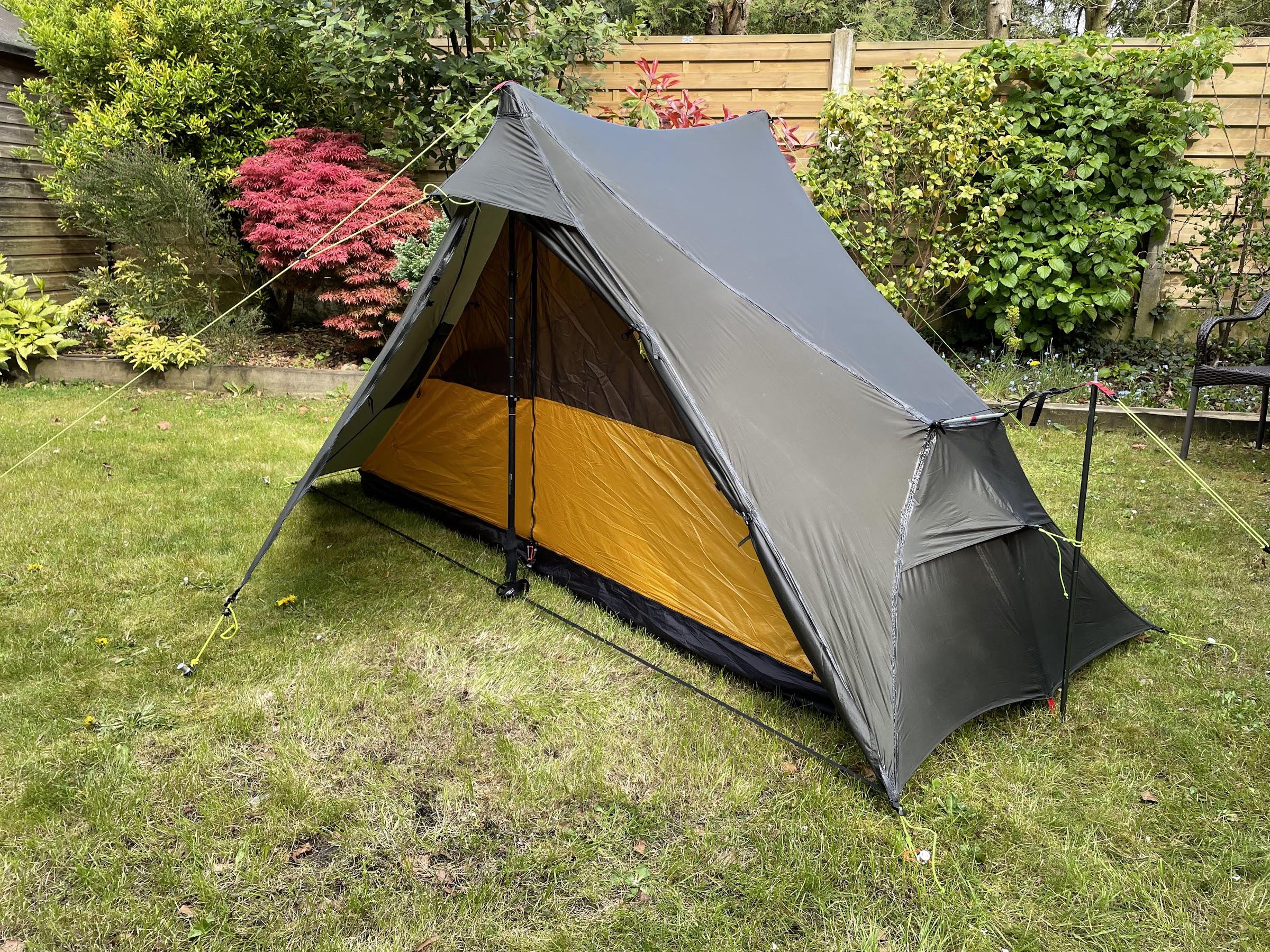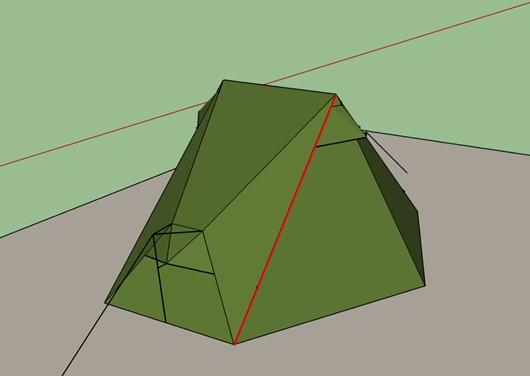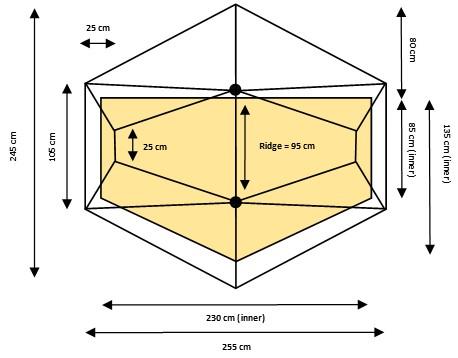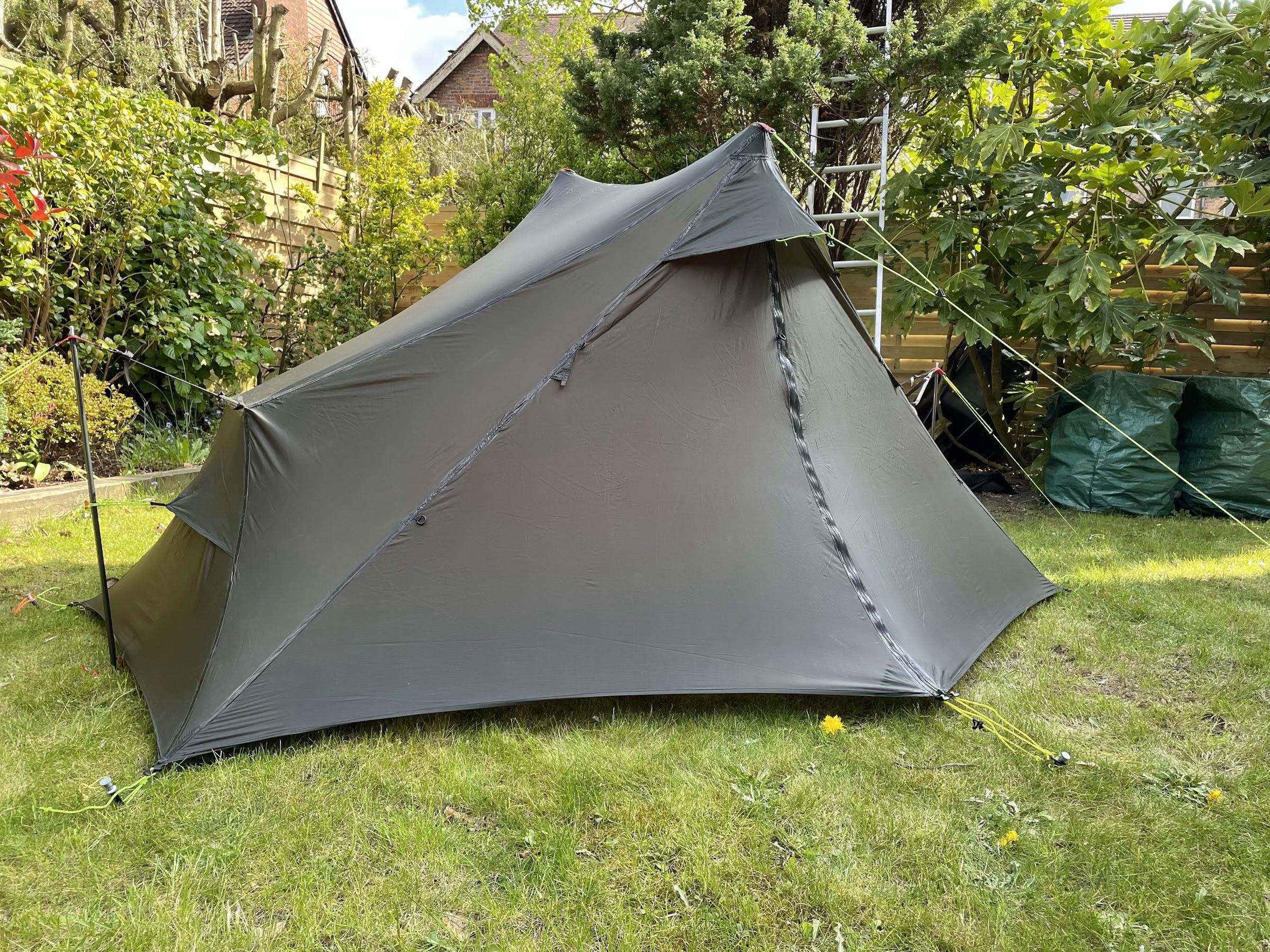Topic
MYOG 1P Trekking pole tent “for demanding conditions”
Forum Posting
A Membership is required to post in the forums. Login or become a member to post in the member forums!
Home › Forums › Gear Forums › Make Your Own Gear › MYOG 1P Trekking pole tent “for demanding conditions”
- This topic has 18 replies, 9 voices, and was last updated 10 months ago by
 Jerry Adams.
Jerry Adams.
-
AuthorPosts
-
Oct 28, 2022 at 4:21 pm #3763137
Hi All,
I am a long time reader / first time poster. Wanted to share my Covid project, even if a bit late. It is a one-person, double-wall, trekking pole tent for “more demanding conditions” (that wording is borrowed from the description of a similar tent by Milan H. here on BackpackingLight a few years ago). I am not really a storm chaser so not sure how bomber it is, but so far so good.
The tent pitched in a pretty perfect location (Wales – UK) this summer:

So, yes, I made the tent during the Covid lockdown period(s) in late 2020 and early 2021. Took me forever … but it was a lot of fun too. It has been in use for two seasons now (2021 and 2022).
The specs and materials are as follows:
1325 gram (outer, inner, end-poles and guy lines). This does not include tent pegs or the trekking poles.
Outer: 30D SilNylon 6.6 from AdventureXpert (I suspect this is the same as the 30D Mountain series from RBTR)
Inner: MEMBRANE 10 Taffeta Nylon from RBTR
Bathtub: Silpoly PU4000 from RBTR
Vents (outer) and the net parts of inner: 1oz Monolite from RBTR
In addition to the two trekking poles, the tent relies on short poles creating more headroom at both ends (11mm DAC alu). The outer is entirely symmetric, except there is only one door (a Vislon Aquaguard 5VT zipper). The inner extends into the “beak area” on the non-door side, thus providing additional space.
The strength of the tent is increased greatly, I think, by a very very taut pitch. I use 9 inch Eastons to active this. The 30D 6.6. fabric seems to thrive with such a taut pitch.
I made a tarp/awning for the tent with RBTR Eco Silpoly (I like trying different fabrics) and supported by a couple of very light carbon poles. A photo here showing the awning in use (somewhere in the UK Lake District). Yes, a cozy place to sit when it rains.
 Finally, a photo showing a bit of the Inner:
Finally, a photo showing a bit of the Inner:
The project would have been impossible without all the super discussion and knowledge of everyone here on BackpackingLight – thank you all so much !!! Very happy to ‘give back’ so feel free to ask questions or request photos of specific features (I think there is a bit of innovation here and there, but also some things that could be improved).
Juup
Oct 28, 2022 at 6:15 pm #3763146Wow! Looks fantastic! Thank you for sharing!
Oct 28, 2022 at 9:16 pm #3763157I’m really impressed by the geometry! Well done. I’d love to see video showing its stability in wind. It looks pretty stable.
Oct 29, 2022 at 7:23 am #3763163Thank you both for the nice words :)
Ryan, I don’t have video … I will put this on my ‘to do list’ … the next windy day I will find an open field.
The weak area of the tent is the long seam from each apex to the corners. See the red line in the following image.

This seam is about 180cm long and the two panels that meet there are sewn on the bias of the fabric. I wanted the lower perimeter to follow the grain everywhere, which I think has benefits. This is one decision I am still uncertain about. The long seam might have behaved better if it was sewn on the grain. I could retrofit a strip of thin grosgrain perhaps, but I have yet to be in weather serious enough for it to be very bad.
Juup
Oct 29, 2022 at 7:37 am #3763164^That is an interesting issue.
Disclaimer: I know very little about making fabric structures (although I do understand the concept of bias and I know that fabric is woven, etc.).
With that disclaimer in mind, I’m curious if bias work proportionally. Could one orient the fabric in the direction I’ve indicated with a yellow line and get a compromise of a little bit of stretch on both red lines? I’m curious if it works like that.
 Oct 29, 2022 at 8:07 am #3763169
Oct 29, 2022 at 8:07 am #3763169nicely done. Pitches really good – you carefully cut and sewed everything. Novel design.
1325 grams total weight = 2.9 poounds – I wish we’d just convert to metric in the U.S. :)
you could sew a strip of, for example, 1/2 inch grosgrain to your red line ridge and it would stiffen it. Maybe make the tent flap less in the wind.
Oct 29, 2022 at 10:10 am #3763174Matthew, I think you are right. Bias stretch seems to be somewhat proportional (but that is me testing by hand only), so your suggestion may have merit. In practice, though, once you have bias stretch (beyond 10-15% off the grain it becomes noticeable) you have a seam that behaves differently. For the perimeter I decided I did not want any stretchy behavior (but, again, not 100% sure about that decision).
Going for Silpoly might change things a bit also. Yes, SilPoly also has bias stretch, but a third less than silnylon (in my experience). Another complication is that my particular 30D silnylon has less bias stretch on one diagonal and more on the other – yes, it is noticeable (!) – I am not sure how common that is. So, all considered, including proportionality, if you have enough fabric there are definitively better and worse ways to cut panels – an “art” informed by science perhaps?
From being a long time reader, I know Jerry knows a thing or two about bias stretch :)
Yes, Jerry’s suggestion is the way for me to go, if the need presents itself. I probably want to stretch the seam a bit whilst sewing on the grosgrain.
Juup
Oct 29, 2022 at 1:50 pm #3763185Sure. That makes sense.
I listened to the recent BPL podcast about UL shelters in inclement weather this morning. Ryan emphasized the importance of stabilizing the peak of a trekking pole supported shelter. I thought about your tent as he was describing the issue and went to see if you had guylines that stabilize your peaks. You do! 🙂
Oct 29, 2022 at 7:02 pm #3763197This is what MYOG should be about – building something innovative that isn’t available commercially.
Can’t have been a straightforward build – very impressed that it pitches so tautly!
I’ve been playing with ideas for a transverse ridge design using extra poles for support, but I think this is smarter than anything I’ve come up with.
The two weaknesses of that geometry are the poor headroom for sleeping and the very large end panels that are vulnerable in the wind. You have tackled both with a single elegant idea.
Like others, I would be seriously interested in some film of how it performs in a 40mph+ blow.
I’d also be interested in the general dimensions, if you can spare a moment to post them.
Oct 30, 2022 at 7:00 am #3763209Thanks – Geoff.
Again, filming is on my ‘to do’ list. Not sure when we will get our next storm here in the north of England. 40mph is a lot of wind – I will bring my Kestrel.
Design … after evolving the idea I could/can see elsewhere (e.g. Tarptent Saddle and Notch, and the recent Dipole … oh, and Milan’s design mention in the OP). Nothing is ever truly original – lol.
The basic dimensions – all in metric (I’m originally from Norway):

I set my Trekking poles to 125, or a bit more depending on the ground. The tips go up into some “mushroom cups”. The end poles are 65 cm (creating 55-60cm of headroom at each end). If I were to do a version 2 I would reduce the height a little – maybe an apex of 120cm? The rest of the dimensions seem good to me.
Another photo. The cat cut on the two beaks are quite dramatic … another thing I am less sure about, but it makes it drum-tight:

Juup
Oct 30, 2022 at 9:31 am #3763217Looks like a beautiful union of form with functio
Oct 30, 2022 at 11:21 pm #3763265Juup,
Beautifully tailored for an absolutely taut pitch to protect against the wind. And you have a nice approach to extending the sidewalls to provide head and shoulder room.
BTW, the ECO 1.1 oz silpoly you used for the add-on tarp seems a lot lighter in the photo than the black, perhaps the Moroccan Blue. Could you post which color it is? Thanks.
Oct 31, 2022 at 4:05 am #3763270Sam,
The light must be playing a trick in the photo. The ECO 1.1 is in fact Dark Olive and it is as dark as the name ‘dark olive’ suggest. It all feels a bit army … if I could do it again I would choose a lighter color. I have a Helsport tent in something similar to Moroccan Blue (of course they call it Helsport Blue). I think a “muted” blue is more uplifting and blends surprisingly well into many landscapes.
More generally, the ECO variety is a bit stiffer (more PU in the blend perhaps?) but also more slippery than the (pre-2021) SilPoly 1.1 XL. I have no experience with the regular SilPoly 1.1.
Juup
Nov 1, 2022 at 10:38 pm #3763397Juup,
Thanks. Agree about muted and lighter colors. But it’s tough to find them in ultralight poly.
Jan 2, 2024 at 3:46 pm #3800626Hi All,
Finally a bit of wind, and an opportunity to do a video. Not quite 40mph, but something to suggest what would happen in 40mph. The camera pans to my Kestrel two or three times to show the wind speed. The Kestrel showed a maximum windspeed for the session of 33.5mph. I think it was around 25mph sustained, with gusts averaging 28-30.

Juup
May 1, 2024 at 8:08 am #3810439Wow! That is holding its shape beautifully in those high winds. I’d say your design choices seem to have worked well!
May 1, 2024 at 8:37 am #3810443Interesting
your natural units for weight and length are metric, but for wind speed it’s MPH
nice video. The tent holds up really good.
May 3, 2024 at 7:01 am #3810590Juup – thanks for the film! Impressive performance…
Jerry –
It seems that Juup is currently in the UK, and we do have a somewhat mongrel system here.
Weight and area are 100% metric these days and volume too – for example with backpack capacities. No cubic inches for us!
But distance has remained stubbornly Imperial. They never changed the road signs, and vehicle dashboards use mph for speed and miles for the odometer.
I guess it’s because we’re located between the sanity of the European system and the insanity of the US system…
May 3, 2024 at 8:01 am #3810597you’re ahead of us, in the U.S.
-
AuthorPosts
- You must be logged in to reply to this topic.
Forum Posting
A Membership is required to post in the forums. Login or become a member to post in the member forums!
Trail Days Online! 2025 is this week:
Thursday, February 27 through Saturday, March 1 - Registration is Free.
Our Community Posts are Moderated
Backpacking Light community posts are moderated and here to foster helpful and positive discussions about lightweight backpacking. Please be mindful of our values and boundaries and review our Community Guidelines prior to posting.
Get the Newsletter
Gear Research & Discovery Tools
- Browse our curated Gear Shop
- See the latest Gear Deals and Sales
- Our Recommendations
- Search for Gear on Sale with the Gear Finder
- Used Gear Swap
- Member Gear Reviews and BPL Gear Review Articles
- Browse by Gear Type or Brand.


 Finally, a photo showing a bit of the Inner:
Finally, a photo showing a bit of the Inner:







